Organisational Culture and Learning Mechanisms: Sanitarium Report
VerifiedAdded on 2021/06/17
|9
|2339
|41
Report
AI Summary
This report provides an in-depth analysis of organisational culture, focusing on the case of Sanitarium Health & Wellbeing. It explores how a positive organisational culture impacts employee performance and contributes to a company's competitive advantage. The report examines the key elements of organisational culture, including ethics, behaviors, and learning mechanisms. It highlights how Sanitarium has implemented strategies for organisational change, such as adapting to consumer preferences and embracing technological advancements. The report also discusses the factors that influence organisational change, the impact of learning mechanisms on employees and the business, and provides recommendations for maintaining a sustainable competitive advantage in the health food industry, including the importance of high-quality product production, cultural diversity, and teamwork. The report emphasizes the importance of continuous learning and adaptation for business success.
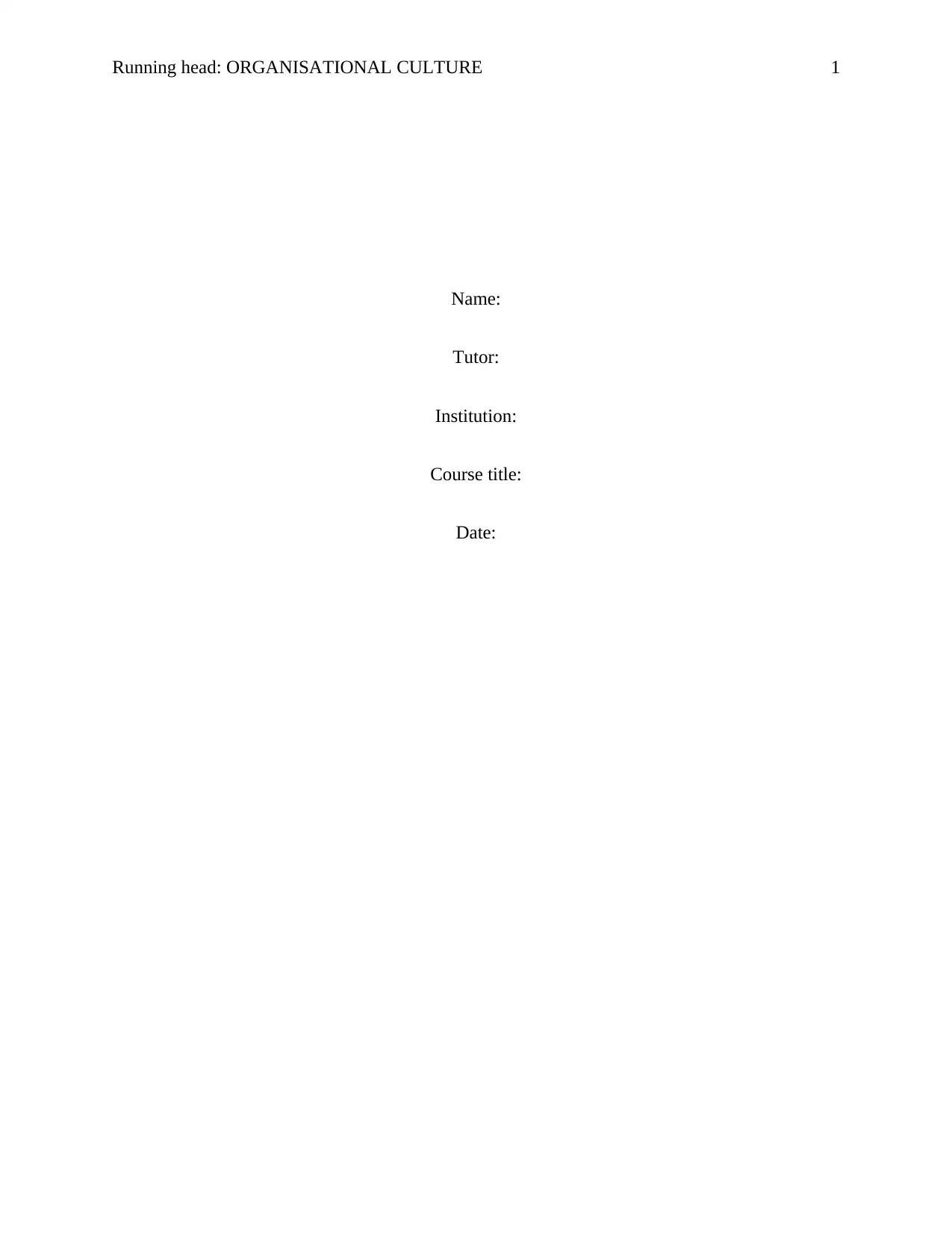
Running head: ORGANISATIONAL CULTURE 1
Name:
Tutor:
Institution:
Course title:
Date:
Name:
Tutor:
Institution:
Course title:
Date:
Paraphrase This Document
Need a fresh take? Get an instant paraphrase of this document with our AI Paraphraser
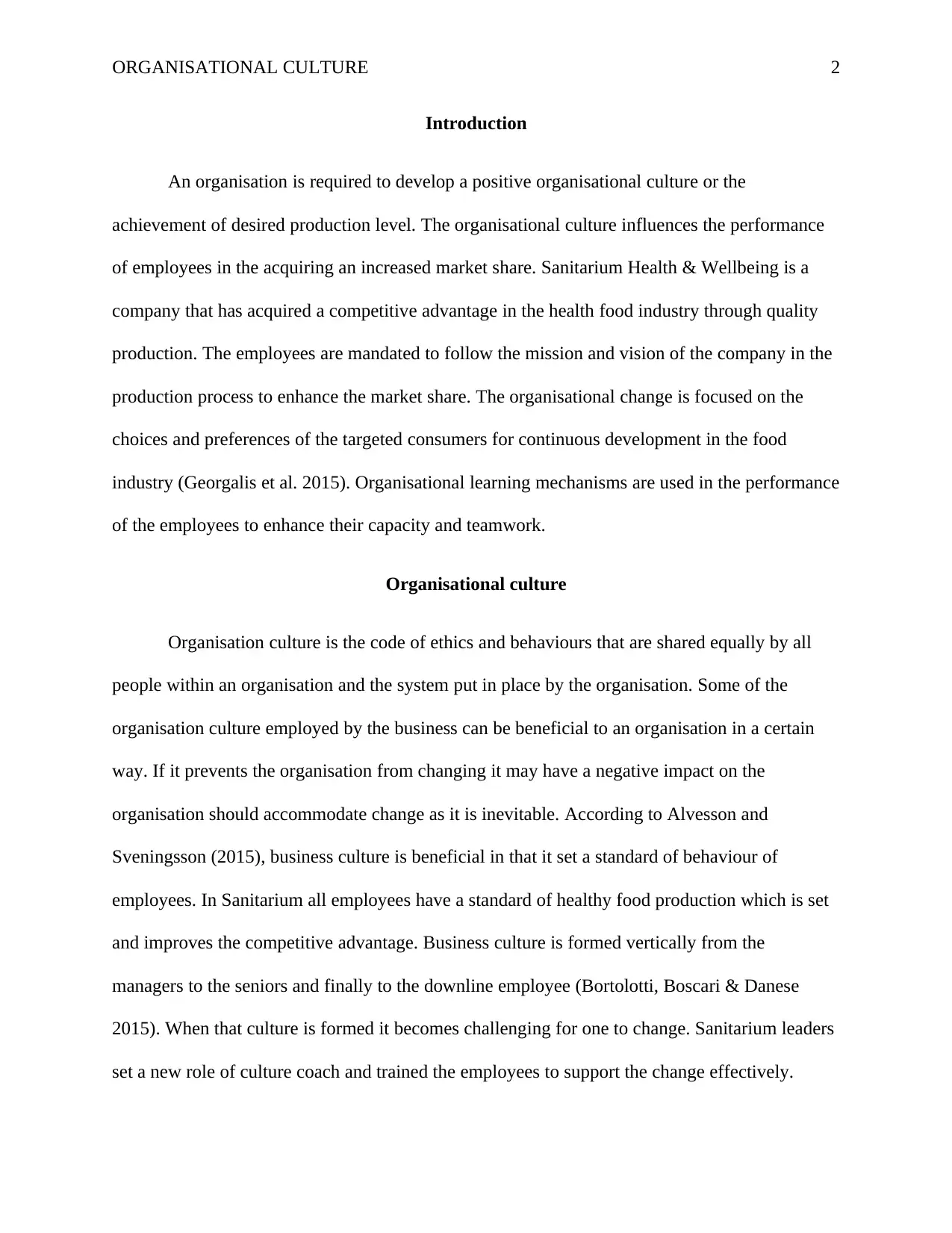
ORGANISATIONAL CULTURE 2
Introduction
An organisation is required to develop a positive organisational culture or the
achievement of desired production level. The organisational culture influences the performance
of employees in the acquiring an increased market share. Sanitarium Health & Wellbeing is a
company that has acquired a competitive advantage in the health food industry through quality
production. The employees are mandated to follow the mission and vision of the company in the
production process to enhance the market share. The organisational change is focused on the
choices and preferences of the targeted consumers for continuous development in the food
industry (Georgalis et al. 2015). Organisational learning mechanisms are used in the performance
of the employees to enhance their capacity and teamwork.
Organisational culture
Organisation culture is the code of ethics and behaviours that are shared equally by all
people within an organisation and the system put in place by the organisation. Some of the
organisation culture employed by the business can be beneficial to an organisation in a certain
way. If it prevents the organisation from changing it may have a negative impact on the
organisation should accommodate change as it is inevitable. According to Alvesson and
Sveningsson (2015), business culture is beneficial in that it set a standard of behaviour of
employees. In Sanitarium all employees have a standard of healthy food production which is set
and improves the competitive advantage. Business culture is formed vertically from the
managers to the seniors and finally to the downline employee (Bortolotti, Boscari & Danese
2015). When that culture is formed it becomes challenging for one to change. Sanitarium leaders
set a new role of culture coach and trained the employees to support the change effectively.
Introduction
An organisation is required to develop a positive organisational culture or the
achievement of desired production level. The organisational culture influences the performance
of employees in the acquiring an increased market share. Sanitarium Health & Wellbeing is a
company that has acquired a competitive advantage in the health food industry through quality
production. The employees are mandated to follow the mission and vision of the company in the
production process to enhance the market share. The organisational change is focused on the
choices and preferences of the targeted consumers for continuous development in the food
industry (Georgalis et al. 2015). Organisational learning mechanisms are used in the performance
of the employees to enhance their capacity and teamwork.
Organisational culture
Organisation culture is the code of ethics and behaviours that are shared equally by all
people within an organisation and the system put in place by the organisation. Some of the
organisation culture employed by the business can be beneficial to an organisation in a certain
way. If it prevents the organisation from changing it may have a negative impact on the
organisation should accommodate change as it is inevitable. According to Alvesson and
Sveningsson (2015), business culture is beneficial in that it set a standard of behaviour of
employees. In Sanitarium all employees have a standard of healthy food production which is set
and improves the competitive advantage. Business culture is formed vertically from the
managers to the seniors and finally to the downline employee (Bortolotti, Boscari & Danese
2015). When that culture is formed it becomes challenging for one to change. Sanitarium leaders
set a new role of culture coach and trained the employees to support the change effectively.
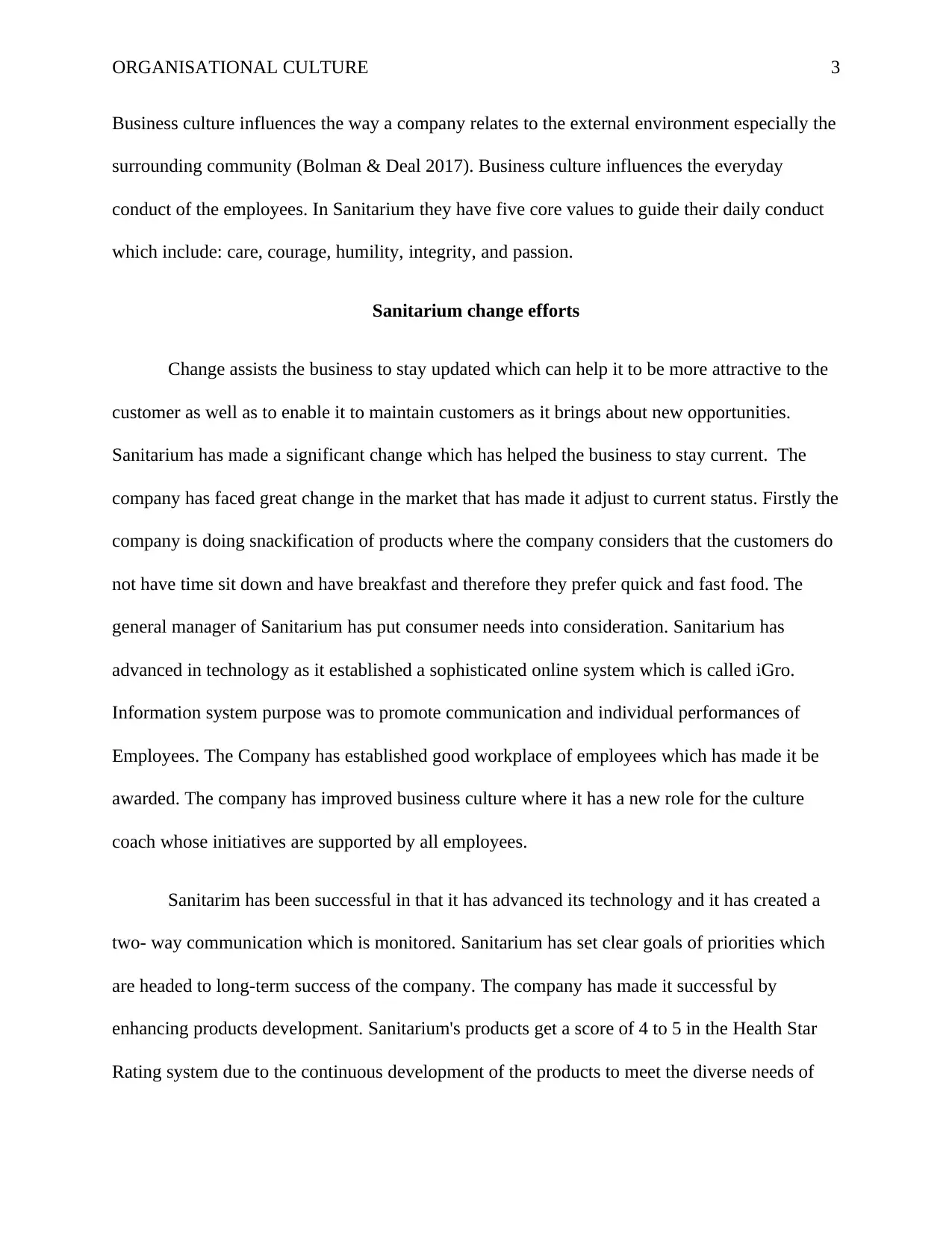
ORGANISATIONAL CULTURE 3
Business culture influences the way a company relates to the external environment especially the
surrounding community (Bolman & Deal 2017). Business culture influences the everyday
conduct of the employees. In Sanitarium they have five core values to guide their daily conduct
which include: care, courage, humility, integrity, and passion.
Sanitarium change efforts
Change assists the business to stay updated which can help it to be more attractive to the
customer as well as to enable it to maintain customers as it brings about new opportunities.
Sanitarium has made a significant change which has helped the business to stay current. The
company has faced great change in the market that has made it adjust to current status. Firstly the
company is doing snackification of products where the company considers that the customers do
not have time sit down and have breakfast and therefore they prefer quick and fast food. The
general manager of Sanitarium has put consumer needs into consideration. Sanitarium has
advanced in technology as it established a sophisticated online system which is called iGro.
Information system purpose was to promote communication and individual performances of
Employees. The Company has established good workplace of employees which has made it be
awarded. The company has improved business culture where it has a new role for the culture
coach whose initiatives are supported by all employees.
Sanitarim has been successful in that it has advanced its technology and it has created a
two- way communication which is monitored. Sanitarium has set clear goals of priorities which
are headed to long-term success of the company. The company has made it successful by
enhancing products development. Sanitarium's products get a score of 4 to 5 in the Health Star
Rating system due to the continuous development of the products to meet the diverse needs of
Business culture influences the way a company relates to the external environment especially the
surrounding community (Bolman & Deal 2017). Business culture influences the everyday
conduct of the employees. In Sanitarium they have five core values to guide their daily conduct
which include: care, courage, humility, integrity, and passion.
Sanitarium change efforts
Change assists the business to stay updated which can help it to be more attractive to the
customer as well as to enable it to maintain customers as it brings about new opportunities.
Sanitarium has made a significant change which has helped the business to stay current. The
company has faced great change in the market that has made it adjust to current status. Firstly the
company is doing snackification of products where the company considers that the customers do
not have time sit down and have breakfast and therefore they prefer quick and fast food. The
general manager of Sanitarium has put consumer needs into consideration. Sanitarium has
advanced in technology as it established a sophisticated online system which is called iGro.
Information system purpose was to promote communication and individual performances of
Employees. The Company has established good workplace of employees which has made it be
awarded. The company has improved business culture where it has a new role for the culture
coach whose initiatives are supported by all employees.
Sanitarim has been successful in that it has advanced its technology and it has created a
two- way communication which is monitored. Sanitarium has set clear goals of priorities which
are headed to long-term success of the company. The company has made it successful by
enhancing products development. Sanitarium's products get a score of 4 to 5 in the Health Star
Rating system due to the continuous development of the products to meet the diverse needs of
⊘ This is a preview!⊘
Do you want full access?
Subscribe today to unlock all pages.

Trusted by 1+ million students worldwide
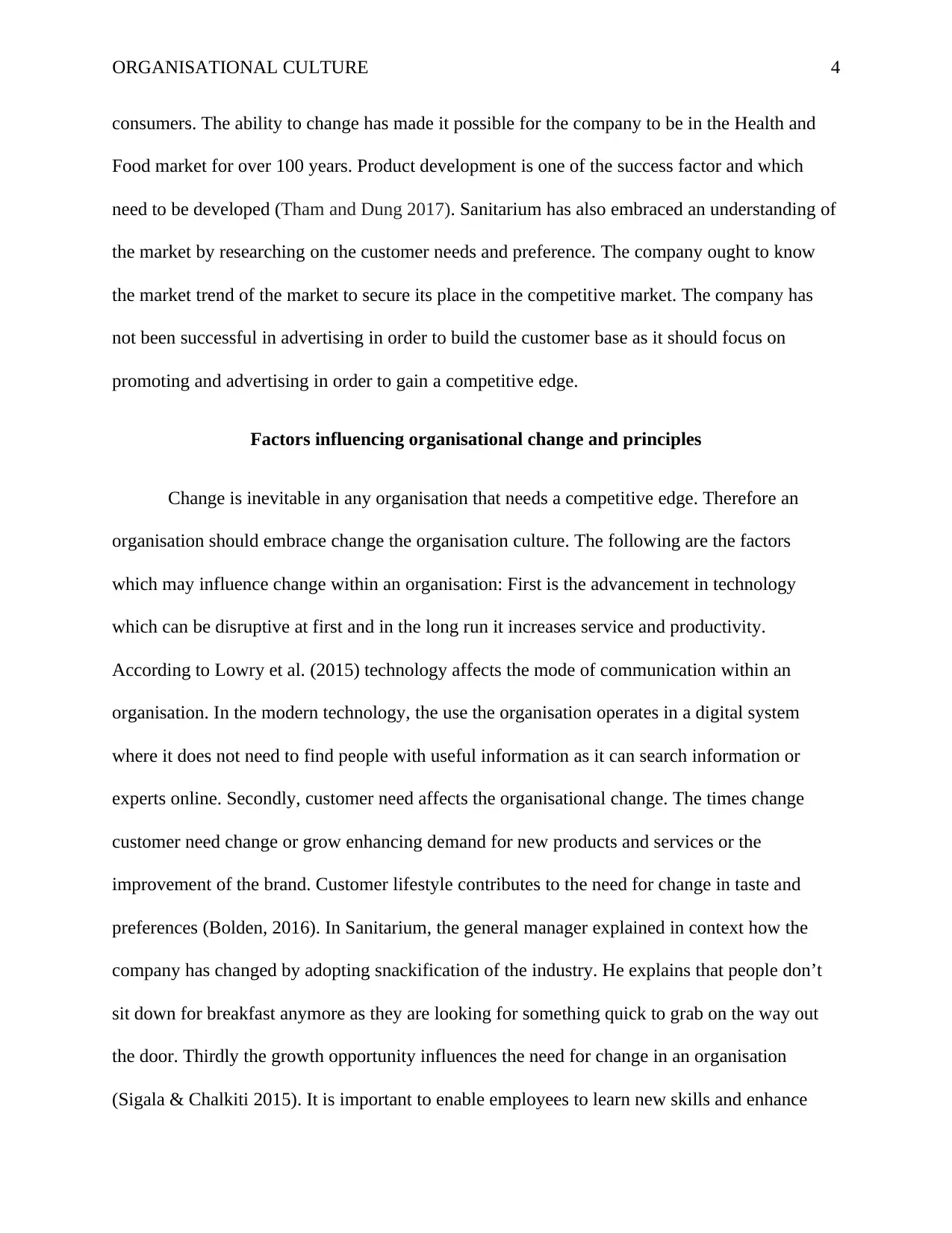
ORGANISATIONAL CULTURE 4
consumers. The ability to change has made it possible for the company to be in the Health and
Food market for over 100 years. Product development is one of the success factor and which
need to be developed (Tham and Dung 2017). Sanitarium has also embraced an understanding of
the market by researching on the customer needs and preference. The company ought to know
the market trend of the market to secure its place in the competitive market. The company has
not been successful in advertising in order to build the customer base as it should focus on
promoting and advertising in order to gain a competitive edge.
Factors influencing organisational change and principles
Change is inevitable in any organisation that needs a competitive edge. Therefore an
organisation should embrace change the organisation culture. The following are the factors
which may influence change within an organisation: First is the advancement in technology
which can be disruptive at first and in the long run it increases service and productivity.
According to Lowry et al. (2015) technology affects the mode of communication within an
organisation. In the modern technology, the use the organisation operates in a digital system
where it does not need to find people with useful information as it can search information or
experts online. Secondly, customer need affects the organisational change. The times change
customer need change or grow enhancing demand for new products and services or the
improvement of the brand. Customer lifestyle contributes to the need for change in taste and
preferences (Bolden, 2016). In Sanitarium, the general manager explained in context how the
company has changed by adopting snackification of the industry. He explains that people don’t
sit down for breakfast anymore as they are looking for something quick to grab on the way out
the door. Thirdly the growth opportunity influences the need for change in an organisation
(Sigala & Chalkiti 2015). It is important to enable employees to learn new skills and enhance
consumers. The ability to change has made it possible for the company to be in the Health and
Food market for over 100 years. Product development is one of the success factor and which
need to be developed (Tham and Dung 2017). Sanitarium has also embraced an understanding of
the market by researching on the customer needs and preference. The company ought to know
the market trend of the market to secure its place in the competitive market. The company has
not been successful in advertising in order to build the customer base as it should focus on
promoting and advertising in order to gain a competitive edge.
Factors influencing organisational change and principles
Change is inevitable in any organisation that needs a competitive edge. Therefore an
organisation should embrace change the organisation culture. The following are the factors
which may influence change within an organisation: First is the advancement in technology
which can be disruptive at first and in the long run it increases service and productivity.
According to Lowry et al. (2015) technology affects the mode of communication within an
organisation. In the modern technology, the use the organisation operates in a digital system
where it does not need to find people with useful information as it can search information or
experts online. Secondly, customer need affects the organisational change. The times change
customer need change or grow enhancing demand for new products and services or the
improvement of the brand. Customer lifestyle contributes to the need for change in taste and
preferences (Bolden, 2016). In Sanitarium, the general manager explained in context how the
company has changed by adopting snackification of the industry. He explains that people don’t
sit down for breakfast anymore as they are looking for something quick to grab on the way out
the door. Thirdly the growth opportunity influences the need for change in an organisation
(Sigala & Chalkiti 2015). It is important to enable employees to learn new skills and enhance
Paraphrase This Document
Need a fresh take? Get an instant paraphrase of this document with our AI Paraphraser
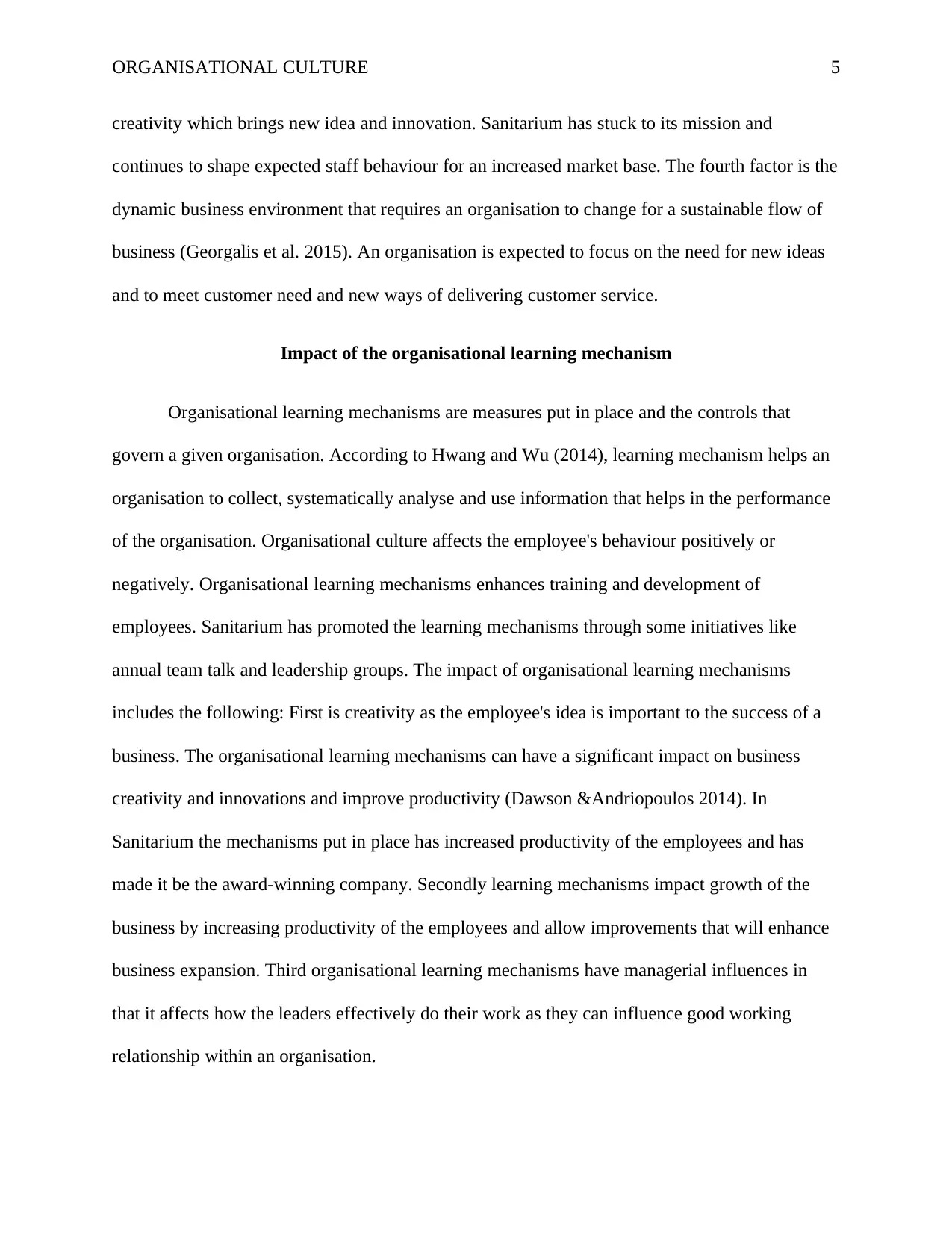
ORGANISATIONAL CULTURE 5
creativity which brings new idea and innovation. Sanitarium has stuck to its mission and
continues to shape expected staff behaviour for an increased market base. The fourth factor is the
dynamic business environment that requires an organisation to change for a sustainable flow of
business (Georgalis et al. 2015). An organisation is expected to focus on the need for new ideas
and to meet customer need and new ways of delivering customer service.
Impact of the organisational learning mechanism
Organisational learning mechanisms are measures put in place and the controls that
govern a given organisation. According to Hwang and Wu (2014), learning mechanism helps an
organisation to collect, systematically analyse and use information that helps in the performance
of the organisation. Organisational culture affects the employee's behaviour positively or
negatively. Organisational learning mechanisms enhances training and development of
employees. Sanitarium has promoted the learning mechanisms through some initiatives like
annual team talk and leadership groups. The impact of organisational learning mechanisms
includes the following: First is creativity as the employee's idea is important to the success of a
business. The organisational learning mechanisms can have a significant impact on business
creativity and innovations and improve productivity (Dawson &Andriopoulos 2014). In
Sanitarium the mechanisms put in place has increased productivity of the employees and has
made it be the award-winning company. Secondly learning mechanisms impact growth of the
business by increasing productivity of the employees and allow improvements that will enhance
business expansion. Third organisational learning mechanisms have managerial influences in
that it affects how the leaders effectively do their work as they can influence good working
relationship within an organisation.
creativity which brings new idea and innovation. Sanitarium has stuck to its mission and
continues to shape expected staff behaviour for an increased market base. The fourth factor is the
dynamic business environment that requires an organisation to change for a sustainable flow of
business (Georgalis et al. 2015). An organisation is expected to focus on the need for new ideas
and to meet customer need and new ways of delivering customer service.
Impact of the organisational learning mechanism
Organisational learning mechanisms are measures put in place and the controls that
govern a given organisation. According to Hwang and Wu (2014), learning mechanism helps an
organisation to collect, systematically analyse and use information that helps in the performance
of the organisation. Organisational culture affects the employee's behaviour positively or
negatively. Organisational learning mechanisms enhances training and development of
employees. Sanitarium has promoted the learning mechanisms through some initiatives like
annual team talk and leadership groups. The impact of organisational learning mechanisms
includes the following: First is creativity as the employee's idea is important to the success of a
business. The organisational learning mechanisms can have a significant impact on business
creativity and innovations and improve productivity (Dawson &Andriopoulos 2014). In
Sanitarium the mechanisms put in place has increased productivity of the employees and has
made it be the award-winning company. Secondly learning mechanisms impact growth of the
business by increasing productivity of the employees and allow improvements that will enhance
business expansion. Third organisational learning mechanisms have managerial influences in
that it affects how the leaders effectively do their work as they can influence good working
relationship within an organisation.
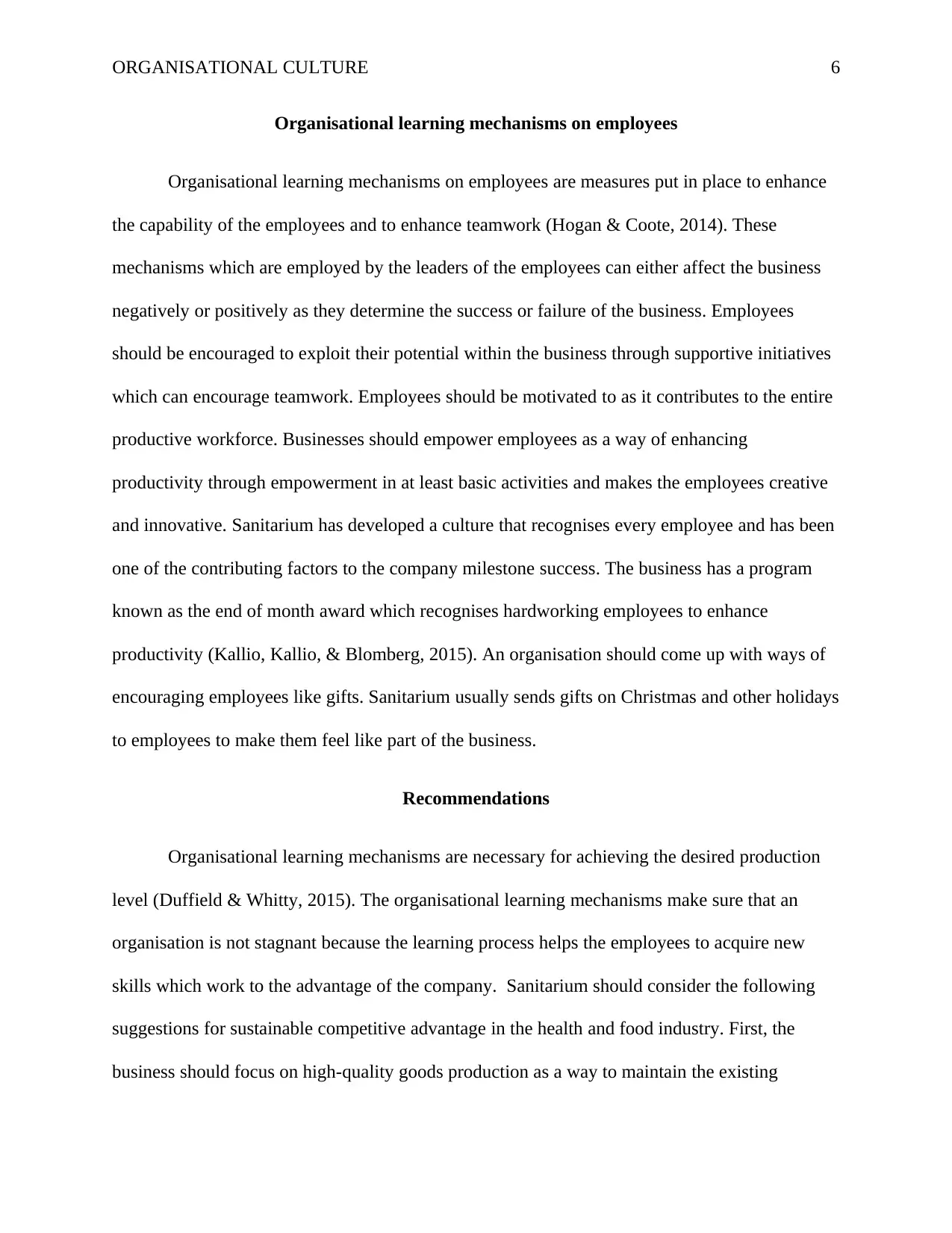
ORGANISATIONAL CULTURE 6
Organisational learning mechanisms on employees
Organisational learning mechanisms on employees are measures put in place to enhance
the capability of the employees and to enhance teamwork (Hogan & Coote, 2014). These
mechanisms which are employed by the leaders of the employees can either affect the business
negatively or positively as they determine the success or failure of the business. Employees
should be encouraged to exploit their potential within the business through supportive initiatives
which can encourage teamwork. Employees should be motivated to as it contributes to the entire
productive workforce. Businesses should empower employees as a way of enhancing
productivity through empowerment in at least basic activities and makes the employees creative
and innovative. Sanitarium has developed a culture that recognises every employee and has been
one of the contributing factors to the company milestone success. The business has a program
known as the end of month award which recognises hardworking employees to enhance
productivity (Kallio, Kallio, & Blomberg, 2015). An organisation should come up with ways of
encouraging employees like gifts. Sanitarium usually sends gifts on Christmas and other holidays
to employees to make them feel like part of the business.
Recommendations
Organisational learning mechanisms are necessary for achieving the desired production
level (Duffield & Whitty, 2015). The organisational learning mechanisms make sure that an
organisation is not stagnant because the learning process helps the employees to acquire new
skills which work to the advantage of the company. Sanitarium should consider the following
suggestions for sustainable competitive advantage in the health and food industry. First, the
business should focus on high-quality goods production as a way to maintain the existing
Organisational learning mechanisms on employees
Organisational learning mechanisms on employees are measures put in place to enhance
the capability of the employees and to enhance teamwork (Hogan & Coote, 2014). These
mechanisms which are employed by the leaders of the employees can either affect the business
negatively or positively as they determine the success or failure of the business. Employees
should be encouraged to exploit their potential within the business through supportive initiatives
which can encourage teamwork. Employees should be motivated to as it contributes to the entire
productive workforce. Businesses should empower employees as a way of enhancing
productivity through empowerment in at least basic activities and makes the employees creative
and innovative. Sanitarium has developed a culture that recognises every employee and has been
one of the contributing factors to the company milestone success. The business has a program
known as the end of month award which recognises hardworking employees to enhance
productivity (Kallio, Kallio, & Blomberg, 2015). An organisation should come up with ways of
encouraging employees like gifts. Sanitarium usually sends gifts on Christmas and other holidays
to employees to make them feel like part of the business.
Recommendations
Organisational learning mechanisms are necessary for achieving the desired production
level (Duffield & Whitty, 2015). The organisational learning mechanisms make sure that an
organisation is not stagnant because the learning process helps the employees to acquire new
skills which work to the advantage of the company. Sanitarium should consider the following
suggestions for sustainable competitive advantage in the health and food industry. First, the
business should focus on high-quality goods production as a way to maintain the existing
⊘ This is a preview!⊘
Do you want full access?
Subscribe today to unlock all pages.

Trusted by 1+ million students worldwide
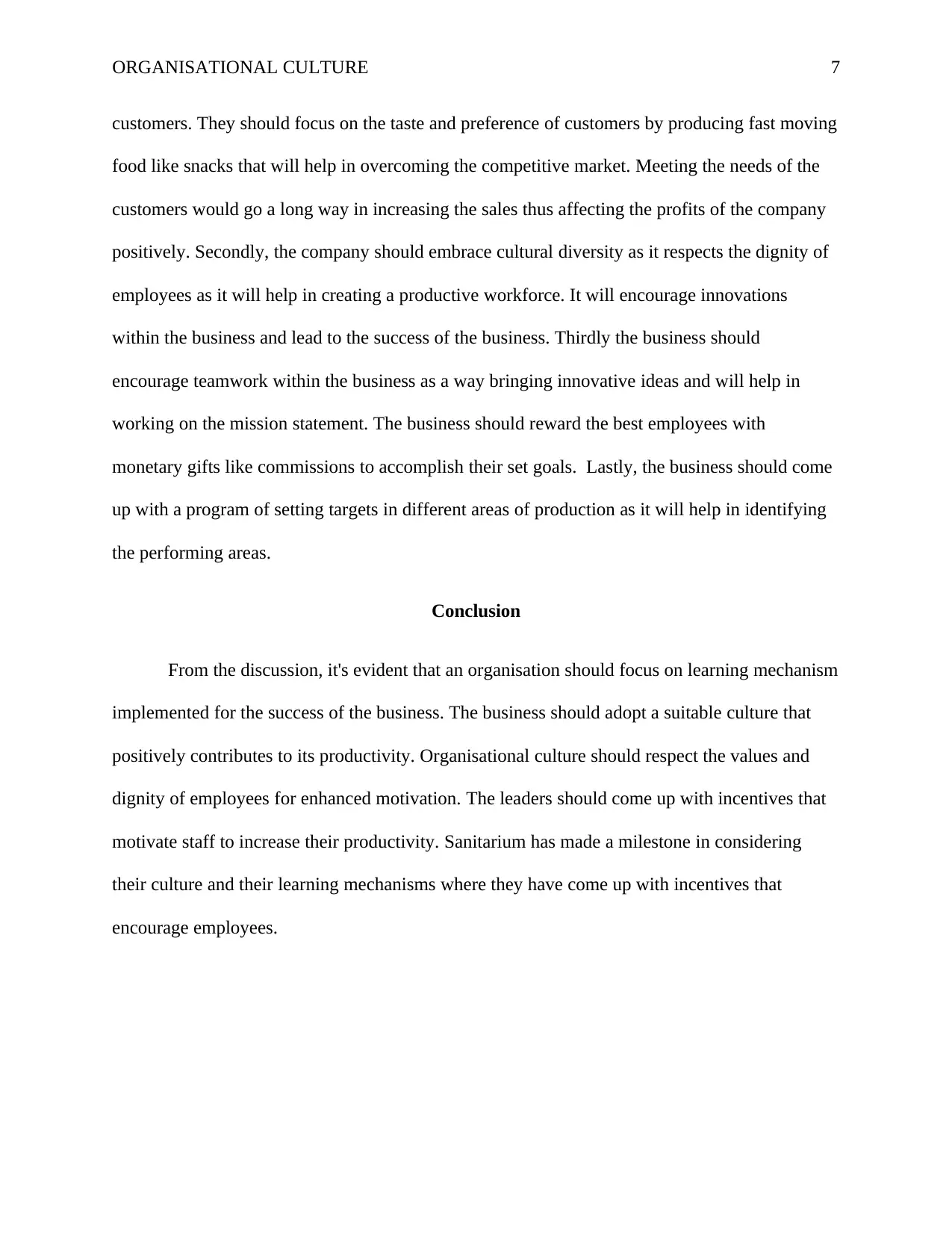
ORGANISATIONAL CULTURE 7
customers. They should focus on the taste and preference of customers by producing fast moving
food like snacks that will help in overcoming the competitive market. Meeting the needs of the
customers would go a long way in increasing the sales thus affecting the profits of the company
positively. Secondly, the company should embrace cultural diversity as it respects the dignity of
employees as it will help in creating a productive workforce. It will encourage innovations
within the business and lead to the success of the business. Thirdly the business should
encourage teamwork within the business as a way bringing innovative ideas and will help in
working on the mission statement. The business should reward the best employees with
monetary gifts like commissions to accomplish their set goals. Lastly, the business should come
up with a program of setting targets in different areas of production as it will help in identifying
the performing areas.
Conclusion
From the discussion, it's evident that an organisation should focus on learning mechanism
implemented for the success of the business. The business should adopt a suitable culture that
positively contributes to its productivity. Organisational culture should respect the values and
dignity of employees for enhanced motivation. The leaders should come up with incentives that
motivate staff to increase their productivity. Sanitarium has made a milestone in considering
their culture and their learning mechanisms where they have come up with incentives that
encourage employees.
customers. They should focus on the taste and preference of customers by producing fast moving
food like snacks that will help in overcoming the competitive market. Meeting the needs of the
customers would go a long way in increasing the sales thus affecting the profits of the company
positively. Secondly, the company should embrace cultural diversity as it respects the dignity of
employees as it will help in creating a productive workforce. It will encourage innovations
within the business and lead to the success of the business. Thirdly the business should
encourage teamwork within the business as a way bringing innovative ideas and will help in
working on the mission statement. The business should reward the best employees with
monetary gifts like commissions to accomplish their set goals. Lastly, the business should come
up with a program of setting targets in different areas of production as it will help in identifying
the performing areas.
Conclusion
From the discussion, it's evident that an organisation should focus on learning mechanism
implemented for the success of the business. The business should adopt a suitable culture that
positively contributes to its productivity. Organisational culture should respect the values and
dignity of employees for enhanced motivation. The leaders should come up with incentives that
motivate staff to increase their productivity. Sanitarium has made a milestone in considering
their culture and their learning mechanisms where they have come up with incentives that
encourage employees.
Paraphrase This Document
Need a fresh take? Get an instant paraphrase of this document with our AI Paraphraser
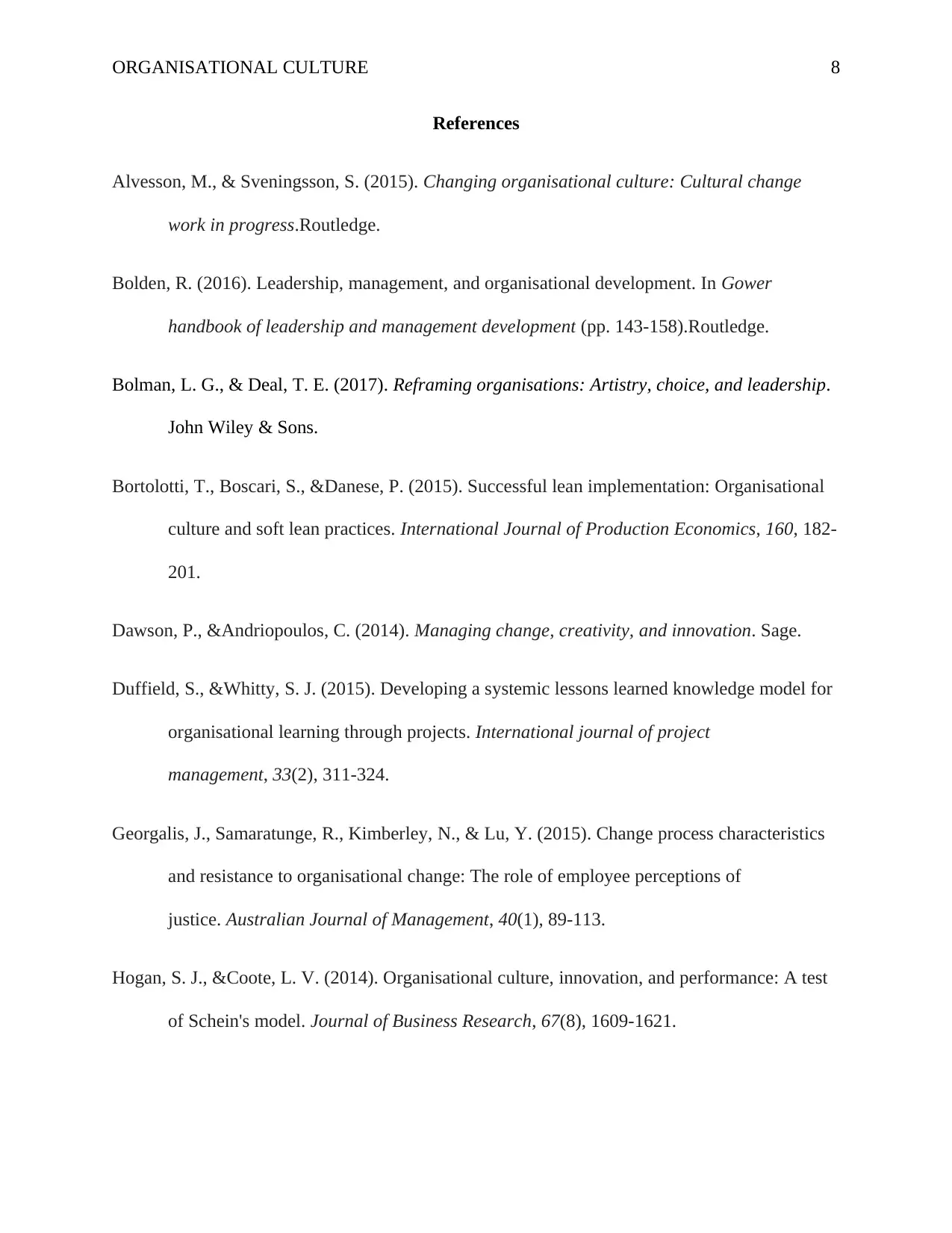
ORGANISATIONAL CULTURE 8
References
Alvesson, M., & Sveningsson, S. (2015). Changing organisational culture: Cultural change
work in progress.Routledge.
Bolden, R. (2016). Leadership, management, and organisational development. In Gower
handbook of leadership and management development (pp. 143-158).Routledge.
Bolman, L. G., & Deal, T. E. (2017). Reframing organisations: Artistry, choice, and leadership.
John Wiley & Sons.
Bortolotti, T., Boscari, S., &Danese, P. (2015). Successful lean implementation: Organisational
culture and soft lean practices. International Journal of Production Economics, 160, 182-
201.
Dawson, P., &Andriopoulos, C. (2014). Managing change, creativity, and innovation. Sage.
Duffield, S., &Whitty, S. J. (2015). Developing a systemic lessons learned knowledge model for
organisational learning through projects. International journal of project
management, 33(2), 311-324.
Georgalis, J., Samaratunge, R., Kimberley, N., & Lu, Y. (2015). Change process characteristics
and resistance to organisational change: The role of employee perceptions of
justice. Australian Journal of Management, 40(1), 89-113.
Hogan, S. J., &Coote, L. V. (2014). Organisational culture, innovation, and performance: A test
of Schein's model. Journal of Business Research, 67(8), 1609-1621.
References
Alvesson, M., & Sveningsson, S. (2015). Changing organisational culture: Cultural change
work in progress.Routledge.
Bolden, R. (2016). Leadership, management, and organisational development. In Gower
handbook of leadership and management development (pp. 143-158).Routledge.
Bolman, L. G., & Deal, T. E. (2017). Reframing organisations: Artistry, choice, and leadership.
John Wiley & Sons.
Bortolotti, T., Boscari, S., &Danese, P. (2015). Successful lean implementation: Organisational
culture and soft lean practices. International Journal of Production Economics, 160, 182-
201.
Dawson, P., &Andriopoulos, C. (2014). Managing change, creativity, and innovation. Sage.
Duffield, S., &Whitty, S. J. (2015). Developing a systemic lessons learned knowledge model for
organisational learning through projects. International journal of project
management, 33(2), 311-324.
Georgalis, J., Samaratunge, R., Kimberley, N., & Lu, Y. (2015). Change process characteristics
and resistance to organisational change: The role of employee perceptions of
justice. Australian Journal of Management, 40(1), 89-113.
Hogan, S. J., &Coote, L. V. (2014). Organisational culture, innovation, and performance: A test
of Schein's model. Journal of Business Research, 67(8), 1609-1621.
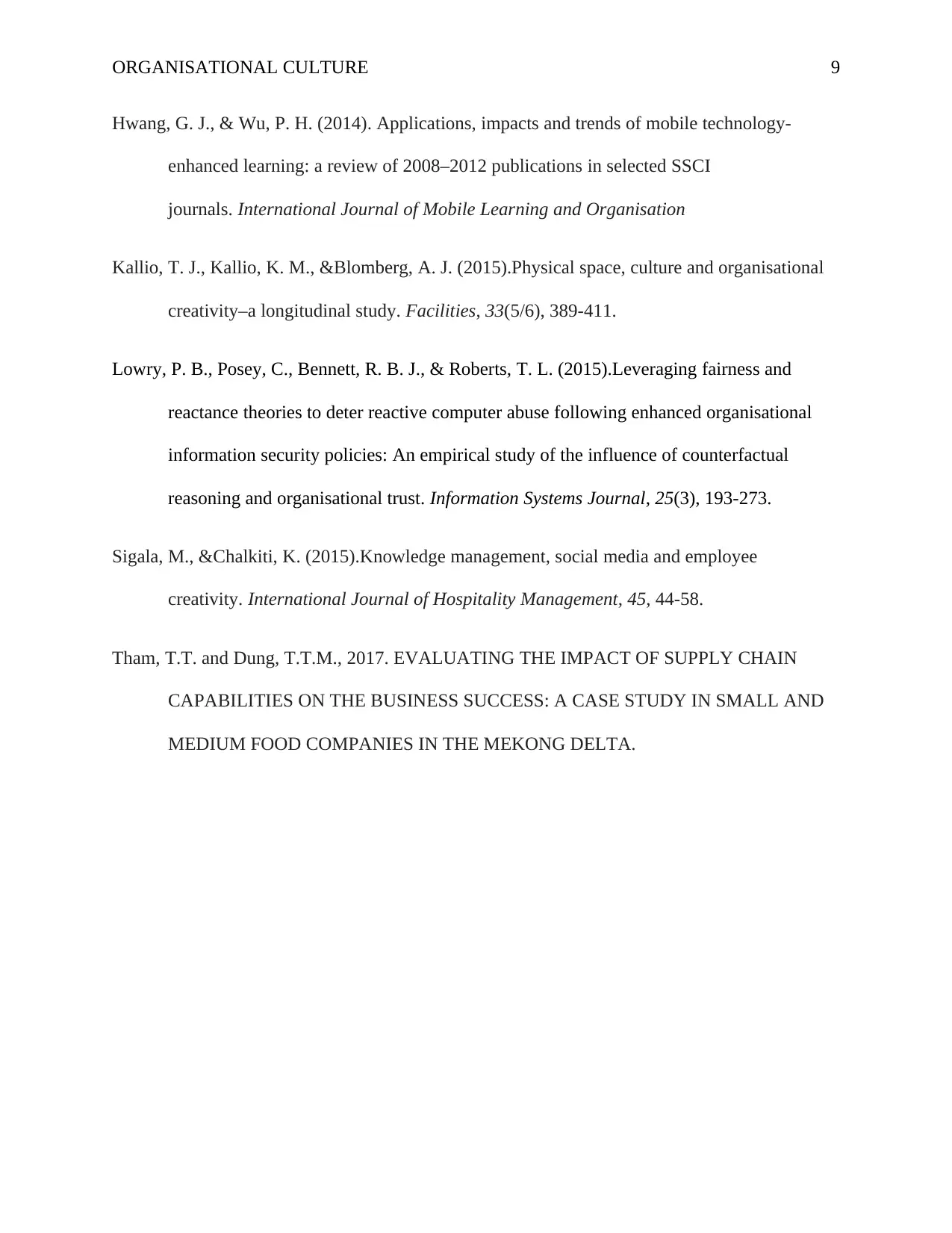
ORGANISATIONAL CULTURE 9
Hwang, G. J., & Wu, P. H. (2014). Applications, impacts and trends of mobile technology-
enhanced learning: a review of 2008–2012 publications in selected SSCI
journals. International Journal of Mobile Learning and Organisation
Kallio, T. J., Kallio, K. M., &Blomberg, A. J. (2015).Physical space, culture and organisational
creativity–a longitudinal study. Facilities, 33(5/6), 389-411.
Lowry, P. B., Posey, C., Bennett, R. B. J., & Roberts, T. L. (2015).Leveraging fairness and
reactance theories to deter reactive computer abuse following enhanced organisational
information security policies: An empirical study of the influence of counterfactual
reasoning and organisational trust. Information Systems Journal, 25(3), 193-273.
Sigala, M., &Chalkiti, K. (2015).Knowledge management, social media and employee
creativity. International Journal of Hospitality Management, 45, 44-58.
Tham, T.T. and Dung, T.T.M., 2017. EVALUATING THE IMPACT OF SUPPLY CHAIN
CAPABILITIES ON THE BUSINESS SUCCESS: A CASE STUDY IN SMALL AND
MEDIUM FOOD COMPANIES IN THE MEKONG DELTA.
Hwang, G. J., & Wu, P. H. (2014). Applications, impacts and trends of mobile technology-
enhanced learning: a review of 2008–2012 publications in selected SSCI
journals. International Journal of Mobile Learning and Organisation
Kallio, T. J., Kallio, K. M., &Blomberg, A. J. (2015).Physical space, culture and organisational
creativity–a longitudinal study. Facilities, 33(5/6), 389-411.
Lowry, P. B., Posey, C., Bennett, R. B. J., & Roberts, T. L. (2015).Leveraging fairness and
reactance theories to deter reactive computer abuse following enhanced organisational
information security policies: An empirical study of the influence of counterfactual
reasoning and organisational trust. Information Systems Journal, 25(3), 193-273.
Sigala, M., &Chalkiti, K. (2015).Knowledge management, social media and employee
creativity. International Journal of Hospitality Management, 45, 44-58.
Tham, T.T. and Dung, T.T.M., 2017. EVALUATING THE IMPACT OF SUPPLY CHAIN
CAPABILITIES ON THE BUSINESS SUCCESS: A CASE STUDY IN SMALL AND
MEDIUM FOOD COMPANIES IN THE MEKONG DELTA.
⊘ This is a preview!⊘
Do you want full access?
Subscribe today to unlock all pages.

Trusted by 1+ million students worldwide
1 out of 9
Related Documents
Your All-in-One AI-Powered Toolkit for Academic Success.
+13062052269
info@desklib.com
Available 24*7 on WhatsApp / Email
![[object Object]](/_next/static/media/star-bottom.7253800d.svg)
Unlock your academic potential
Copyright © 2020–2025 A2Z Services. All Rights Reserved. Developed and managed by ZUCOL.




